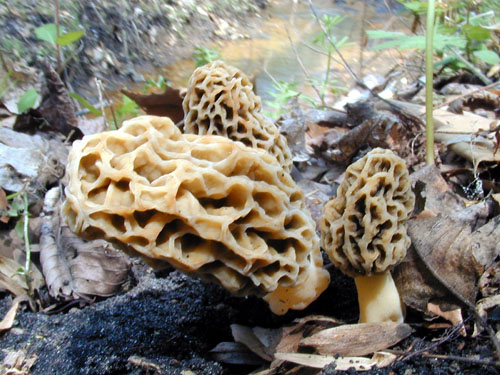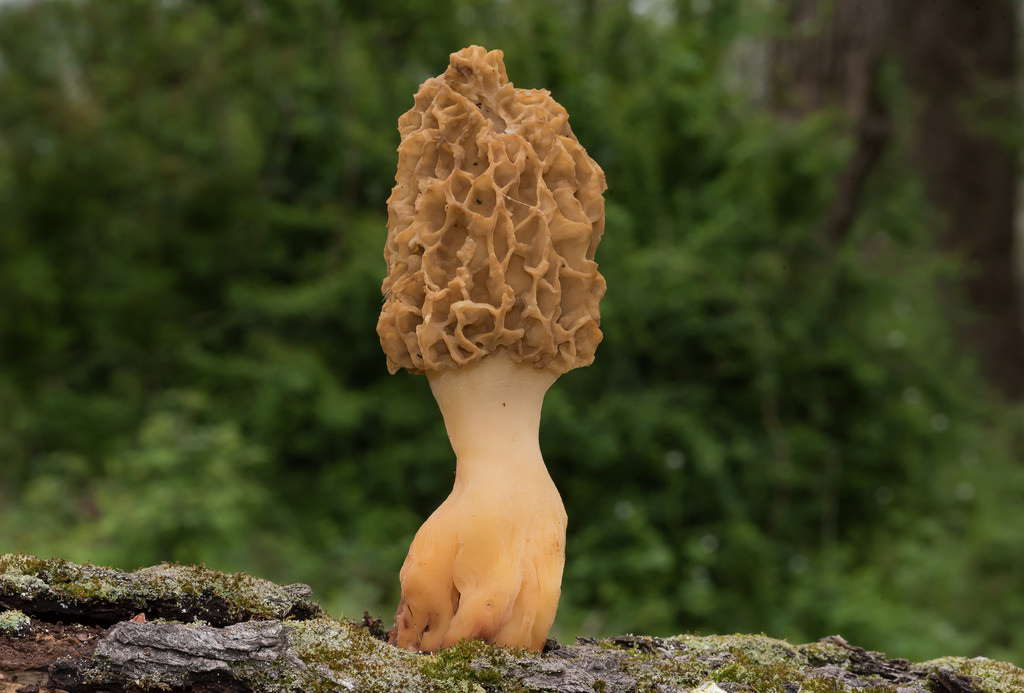Map Snapshot



















112 Records
Status
Found solitary or in scattered groups on ground under hardwoods, most often in floodplains, damp pockets on hillsides, old orchards; non-acidic soil. Spring.
Morel taxonomy is complex and in flux. There are multiple species within the groups of "yellow" and "black" morels as determined by DNA analysis. Although the precise number of species has not been established, it has been determined the species known as Morchella esculenta is a European species that does not occur in North America.
Description
Hollow. Head: Sponge-like yellow-brown to tan, oval with elongated pits and ridges; base of head attached to stalk. Stalk: White to pale yellow with lengthwise ridges, sometimes enlarged at the base.
Seasonality Snapshot
Source: Wikipedia
| Morchella americana | |
|---|---|

| |
| Scientific classification | |
| Domain: | Eukaryota |
| Kingdom: | Fungi |
| Division: | Ascomycota |
| Class: | Pezizomycetes |
| Order: | Pezizales |
| Family: | Morchellaceae |
| Genus: | Morchella |
| Species: | M. americana
|
| Binomial name | |
| Morchella americana Clowez & Matherly (2012)
| |
Morchella americana (also called the yellow morel)[1] is a North American species of fungus in the family Morchellaceae.
Taxonomy
[edit]The species was described as new to science in 2012. In 2014, Richard et al. clarified its taxonomic status, retaining the name Morchella americana of Clowez and Matherly (2012) over M. esculentoides.[2][3]
Etymology
[edit]The specific epithet americana refers to the species' occurrence in North America.
Description
[edit]The cone-shaped cap is rounded or pointed, about 3–10 centimetres (1–4 inches) tall with a honeycomb-like network of ridged openings. The whitish stipe is shorter than the cap, sometimes bulbous, wrinkled and/or stained yellow, and hollow. The spore print is off-white.[1]
Similar species
[edit]In the Great Lakes region of eastern North America, the range of M. americana overlaps with M. ulmaria; the two species cannot be reliably distinguished without DNA sampling.[4] Other similar species include M. diminutiva, M. prava and others in the genus, in addition to Verpa bohemica and Gyromitra species.[1]
Distribution and habitat
[edit]Found throughout North America except the Gulf Coast,[1] the species is common east of the Rocky Mountains in a range stretching from Ontario south to Texas, Arkansas, Alabama, Georgia and South Carolina. In western North America, the species typically is found under hardwood, especially cottonwood trees in river bottoms, or with apple trees or ashes in forest, riparian or urban settings.[1]
M. americana, identified as phylogenetic species "Mes-4", has also been found in Turkey, France, and Germany, but is suspected of having been introduced to Europe from North America.[5][2]
References
[edit]- ^ a b c d e Audubon (2023). Mushrooms of North America. Knopf. p. 35. ISBN 978-0-593-31998-7.
- ^ a b Richard, Franck; Bellanger, Jean-Michel; Clowez, Philippe; Courtecuisse, Regis; Hansen, Karen; O'Donnell, Kerry; Sauve, Mathieu; Urban, Alexander; Moreau, Pierre-Arthur (30 December 2014). "True morels (Morchella, Pezizales) of Europe and North America: evolutionary relationships inferred from multilocus data and a unified taxonomy". Mycologia (Preliminary version published online). 107 (2): 359–382. doi:10.3852/14-166. PMID 25550303. 14-166.
- ^ Clowez, Philippe (2012). "Les morilles. Une nouvelle approche mondiale du genre Morchella". Bull Soc Mycol Fr. 126: 199–376.
- ^ Kuo M, Dewsbury DR, O'Donnell K, Carter MC, Rehner SA, Moore JD, Moncalvo JM, Canfield SA, Stephenson SL, Methven AS, Volk TJ (11 April 2012). "Taxonomic revision of true morels (Morchella) in Canada and the United States". Mycologia. 104 (5): 1159–77. doi:10.3852/11-375. PMID 22495449. S2CID 45219627.
- ^ Taşkın, H.; Büyükalaca, S.; Hansen, K. & O’Donnell, K. (March–April 2012). "Multilocus phylogenetics analysis of true morels (Morchella) reveals high levels of endemics in Turkey relative to other regions of Europe". Mycologia. 104 (2): 446–461. doi:10.3852/11-180. PMID 22123659. S2CID 207685509.





























